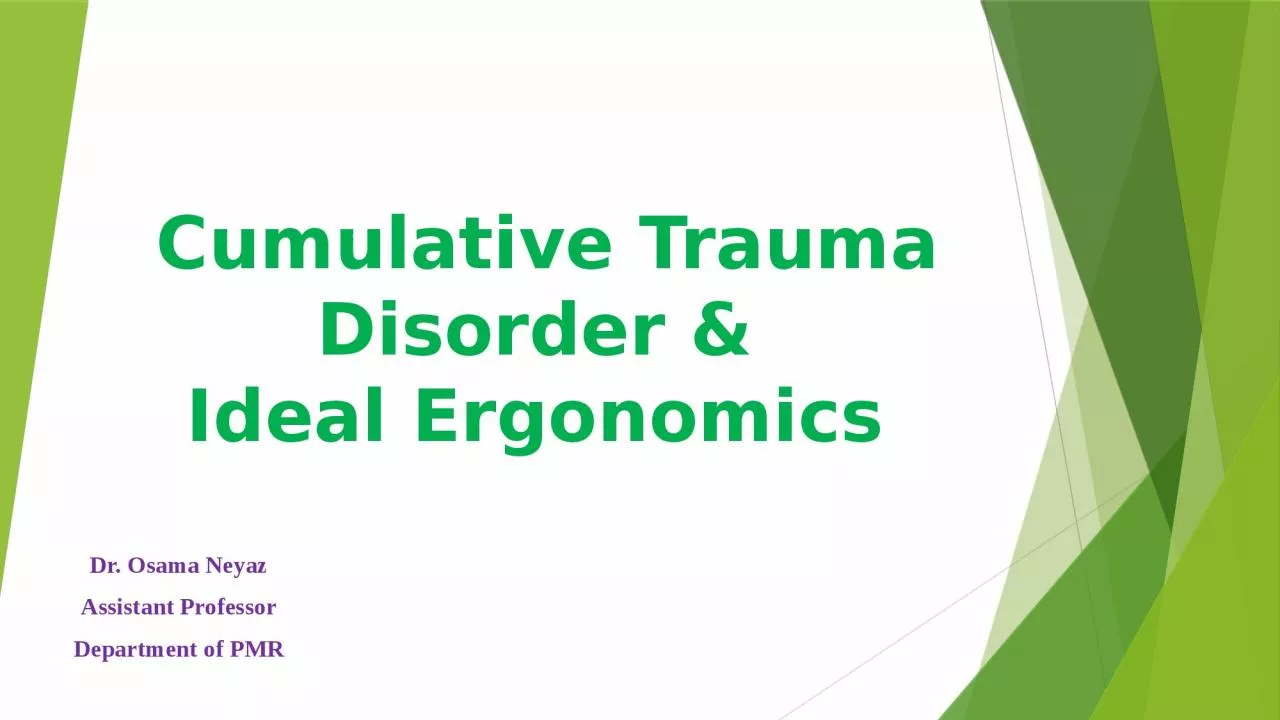

amp Ideal Ergonomics Dr Osama Neyaz Assistant Professor Department of PMR Synonyms Cumulative trauma disorder Repetitive motion syndrome Repetitive strain injury Work related disorder ID: 935016
Download Presentation The PPT/PDF document "Cumulative Trauma D isorder" is the property of its rightful owner. Permission is granted to download and print the materials on this web site for personal, non-commercial use only, and to display it on your personal computer provided you do not modify the materials and that you retain all copyright notices contained in the materials. By downloading content from our website, you accept the terms of this agreement.
Slide1
Cumulative Trauma Disorder & Ideal Ergonomics
Dr. Osama Neyaz
Assistant Professor
Department of
PMR
Slide2Synonyms Cumulative trauma disorderRepetitive motion syndromeRepetitive strain injuryWork related disorder
Myofascial pain
Slide3Overview Introduction Definition
Patho-mechanics
Stages
Clinical feature
Clinical Evaluation
Treatment
Ergonomics
Slide4Introduction A. Cumulative: developed gradually over periods of weeks, months, or even years.
cumulative
concept:
each
repetition of an activity produces some trauma or wear
and tear
on the tissues and joints of the
body.
B. Trauma:
bodily injury from mechanical
stresses.
C. Disorders:
physical ailments or abnormal conditions.
Slide5Definition CTD are work-related musculoskeletal injuries that affect the musculoskeletal, peripheral nervous, and neurovascular systems that are caused or aggravated by
occupational
exposure
to
ergonomic
hazards
.
Slide6Common CTDsNeck tension syndromeRotator cuff syndrome
Epicondylitis
Tendonitis
Tenosynovitis
Ganglion
Trigger
finger
Pronator
teres
syndrome
Radial
tunnel syndrome
Carpal tunnel syndrome
Guyon tunnel
syndrome
Slide7Mechanisms of injurySustained or constrained PostureRepetition
Force
full exertions
vibration
combinations
Slide8Patho-physiology
Slide9Stages
Slide10Signs and symptoms Pain Tenderness
Swelling
Unreasonable
fatigue
Disturbed sleep
Tingling & Numbness
Difficulty
performing tasks or moving specific parts of the
body
Slide11Clinical EvaluationIdentifying the specific injury Determine the degree to which the disorder is work related
‘Each disorder has different cause, treatment & prognosis’
Slide12History Elicit the onset, location, duration, frequency, intensity of the symptoms Whether symptoms started before or after employment
If symptoms exacerbated by the job
Previous injuries or fracture to that area
If any medical condition known to be associated with symptoms
Slide13Physical examinationInspection for sign of inflammation, ganglia cysts or deformityPalpation - warmth Passive, active & resisted ROM
Special tests e.g.
Phalen’s
test, Finkelstein’s test
Slide14Medical conditions associated with CTD AmyloidosisArthropathies & connective tissue
disorders e.g. RA
, SLE,
gout,
OA and
SpA
Cancer
Diabetes mellitus
Hypothyroidism
Obesity
Pregnancy
Slide15LABORATORY TESTINGCBCESR and CRP
Serum RF, Antinuclear antigen (ANA),
HLA-B27
Diabetic
screening
S. TSH
S.
calcium, phosphorus, uric acid, alkaline and acid phosphatase
for
metabolic
, endocrine and neo-plastic
conditions
Serum protein electrophoresis
Slide16Treatment Rehabilitation programmeApplication of Heat and ColdNSAIDs
Exercises
Splints
Surgical intervention if conservative trail fails.
Slide17Ergonomics“The science of studying people at work and then designing tasks, jobs, information, tools, equipment, facilities and the working environment so people can be safe and healthy, effective, productive and comfortable”*
‘Fitting
the job to the
worker’
*
Ergonomic Design
Guidelines, Auburn Engineering, Inc., 1998
.
Slide18Posture is the most important aspect when looking at workstation design.
Slide19Chairs HeightBack supportSeat tilt
Depth
Width
Armrests
Slide20HeightHighest point of the seat,
just
below your
kneecap.
Feet should
rest firmly on the floor when seated
Slide21Back support & Seat tilt
Lumbar
pad
should supports
the
natural curve
of your lower back (lumbar curve).
Upper
body should
slightly
tilt
to reclined
.
*110°
is usually
recommended.
Seat tilt
of
5
°
is
usually recommended
.
Slide22Seat Depth & WidthThe seat
pan should support
the back
without the front of the seat pressing against the back of your knees.
Wide enough
not apply pressure to your thighs.
Narrow
enough to
reach
the
armrests.
Slide23ArmrestsArmrest should be adjusted to elbow height.Too high will shrug the shoulders
Too low will depressed
the shoulders
- Affect the posture of the back and neck.
Slide24Input devicesPosition - Upper arms should be relaxed and by your side, your elbows bent at a right angle (90 degrees) and your wrists straight.Keyboard – should promote neutral wrist
and hand posture.
Negatively tilted keyboard
Mouse –
same
level as the
keyboard
easy
to
reach
switch
the
side by
changing
hands
Slide25MonitorDistance
As
far away as
possible (
60-90 cm
)
Increase
the size of the font
Height
and
location
Top
of the monitor just below eye
level
Tilt
15 degrees
Slide26Computer & Desk StretchesApproximately four minutesDo these stretches
every hour
Slide27Good Posture
Slide28Thank you